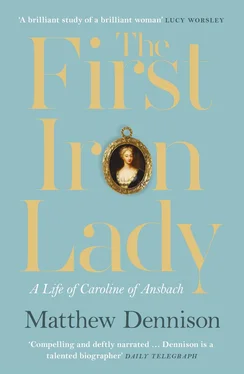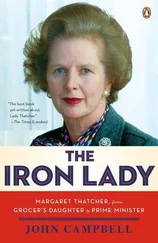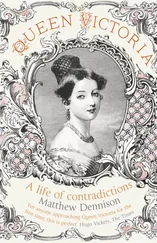In Berwart’s palace, in a room quite different from that later mocked up for tourists as ‘Queen Caroline’s apartment’, complete with rococo boiseries and Chinese porcelain, Caroline of Ansbach was born on 1 March 1683. Otherwise, save in Hollar’s etching, the old palace of Ansbach has been forgotten. It was remodelled and extended at the turn of the eighteenth century, after Caroline had already left it.
Today’s Residenz Ansbach – now the administrative seat of the government of Middle Franconia – is an exercise in baroque symmetry begun in 1705: routinely grand. Last whiffs of absolutism confer a bland sort of glamour. Externally, pilasters divide ribbons of tall windows; from the pediment statues gesture sturdily. Vanished is the dark, mysterious poetry invoked by Hollar, gone the mighty stork on its twiggy nest, long dead those spidery figures chasing a stag, jolting in their carriage, working iron or bronze in hidden forges. Nothing remains to recall the older palace at the heart of this cluster of timber-built houses and soaring churches and small-scale provincial aspirations set amid green meadows and distant wooded hills above the Rezat river.
Several of Berwart’s interiors survived the remodelling. There is little today save a handful of portraits that would be recognisable to the blonde-haired princess baptised into the Lutheran faith in the spring of 1683 as Wilhelmine Karoline. In the event, circumstances throughout her life would discourage her from looking back. First family tragedy, later political expediency, forced her to fix her gaze on the present and the future. Her contemporaries discounted her early years. British printmakers even confused her baptismal names: Edward Cooper called her ‘Wilhelmina Charlotta’, Thomas Bowles ‘Wilhelmina Charlotte’. 2It seems likely that she was known first as ‘Wilhelmine’. The switch to ‘Caroline’ coincided with the prospect of a life in Britain, following her marriage into the reigning house of Hanover. ‘Caroline’ was easier for the British to pronounce.
Begun in the year of Caroline’s marriage, Ansbach’s new palace is an exercise in regal conformity: a cumbrous assertion of majesty inspired, like so much German palace-building, by Louis XIV’s Versailles. Her own later life would share this concern with successfully projecting authority. Like the building she never knew, her future career encompassed baroque bombast and a focus on order, reason and measure more typical of the Enlightenment. All that lay ahead.
In March 1683, her birth was of no importance. No poets hymned her tiny limbs, no kerfuffle ruffled diplomats’ dispatches. Only love could justify John Frederick, Margrave of Brandenburg-Ansbach, beginning a second family after the death of his wife Joanna Elizabeth of Baden-Durlach. The three surviving children of his first marriage, Christian Albert, Dorothea Frederica and George Frederick – seven, six and four respectively – already filled his turreted palace with noise and the surety of another generation. By 1683, Ansbach required from its ruling prince no more sons or daughters. Caroline was a baby without purpose or promise. Save in a mother’s heart, few aspirations can have been nurtured for her. Yet there is no reason to doubt her parents’ happiness at her birth. Given the existence already of two male heirs to the Ansbach patrimony, even her sex cannot have disappointed.
John Frederick was a man of imagination and culture. He wrote fiction, in the manner of contemporary French authors, published under the pseudonym Isidorus Fidelis (‘Faithful Isidore’), and expanded and reorganised the court library; he loved music, especially opera. He employed the composer Johann Wolfgang Franck as director of court music at the outset of his career; he was a patron of composer and well-known castrato singer Antonio Pistocchi. Franck wrote two new operas during his six years in Ansbach, including a version of the story of Perseus and Andromeda: chivalry overcoming tyranny. 3Pistocchi meanwhile would first teach Caroline to sing. 4And John Frederick commissioned for his palace a double portrait of himself and his new wife. She was Eleonore Erdmuthe Louise, elder of the two daughters of John George I, Duke of Saxe-Eisenach. The home she left behind her lay 150 miles to the north, on the north-west edge of the Thuringian forest, an enclave every bit as insignificant as tiny Ansbach.
An uxorious image, John Frederick’s marriage portrait suggests a man happy with his spouse. The sturdy German margrave leans towards his charming consort, seven years his junior, and proudly clasps her hand. Like many another princess, she was acclaimed by poets as the loveliest alive; a shrewder observer noted her mildness of temper, compliance, good sense. 5Her double chin, plump forearms and breasts as deliciously rounded as the peaches in the basket she cradles, indicate her conformity to prevailing notions of beauty. Visual metaphors of fecundity are easily unravelled. Less so her auburn hair, possibly a wig, a tottering confection of marshmallow curls. Corkscrew ringlets foam about her pale shoulders. She wears a necklace of pearls and bulky, square-cut jewels glimmer on her bodice. John Frederick wears a brown wig of a style that had changed little since the middle of the century.
The couple’s pale eyebrows suggest that their colouring was naturally fair – as it appears in Samuel Blesendorff’s engraving of the painting, as well as mezzotints of an earlier portrait of John Frederick attributed to Willem Wissing, in breastplate and chivalric orders. 6A contemporary engraving of John Frederick by Mark Anton Gufer shows that Caroline inherited from her father her distinctively rounded face, with pointed chin and long, straight, pointed nose; her brother William Frederick resembled her closely. 7From her mother Caroline would inherit her quantities of pale blonde hair and, as time would show, considerable strength of character. Her father bequeathed her in addition bibliophilia, a relish for poetry and music, his manipulation of cultural patronage as a medium for communicating power. Although she lacked Eleonore’s uncontested beauty, Caroline would share her ‘expressive countenance’. 8Inviting curves and a splendid embonpoint – a plenitude of milk-white fleshiness and snowy bosom – were also gifts of Eleonore’s. A possibly apocryphal story has a youthful Caroline being followed through Ansbach’s narrow streets by a crowd of gawping admirers. Like Eleonore, she would inspire devotion in her future spouse. Like both her parents, she would make an essentially arranged marriage successful and rewarding.
At the outset she was born to high-ranking obscurity, cut off from the common herd in Berwart’s palace with its garden concealed between high walls, her destiny at best marriage into a court like her father’s. Seventeenth-century Ansbach was part of the Holy Roman Empire. This confederation of around three hundred more-or-less autonomous territories extended across modern-day Germany, Austria, the Czech Republic and beyond; its Habsburg overlord was chosen by a handful of the Empire’s leading princes, whose role in the process earned them the title ‘elector’ along with covetable sinecures. 9Situated between Nuremberg to the north-east and Munich further south, Ansbach lies in present-day Bavaria; its outlook focused on its German neighbours. Since the fifteenth century its governing family had been kinsmen of the Hohenzollerns, rulers of the much larger north German territory of Brandenburg, in one eighteenth-century estimate ‘one of the most ancient and illustrious families in Europe’. 10As their title suggests, the margraves of Brandenburg-Ansbach had connections. They had money too, from silver mines in the Harz Mountains, close to the Brandenburg border. John Frederick matched imagination with initiative, promoting traditional local manufactures, including weaving and metal-smithing. But his power was finite, confined like his sphere of influence to an area smaller than an English county, and his family history was middling. Caroline would be the first of Ansbach’s princesses to marry a crown.
Читать дальше












